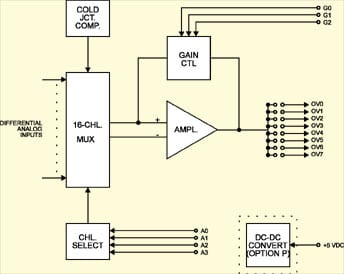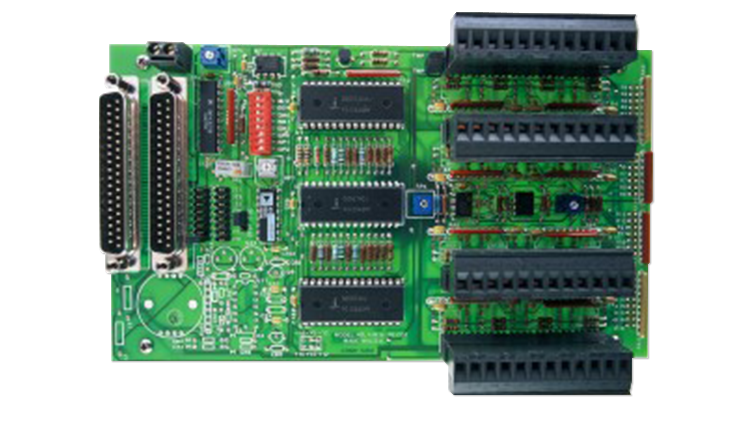AIM-16 Family
Features
- Supports mixed Sensors: Thermocouples, RTDs, strain gages, voltage and current inputs
- Multiplexes 16 differential inputs to one analog single-ended output
- Cold junction compensation and break detect for thermocouple inputs.
- Gain programmable (0.5 to 1000) channel-by-channel
- Screw terminals for input terminations on plug-in blocks
- Designed, made, supported, and manufactured in the USA
$395.00
In StockDescription
Model AIM-16 accepts, pre-amplifies, and multiplexes analog signals for application to an analog-to-digital converter installed in a host computer. Each AIM-16 concentrates 16 differential analog input channels into one single-ended analog output channel. Up to eight AIM-16s can be cascaded providing total capacity for 128 inputs to an “8-input A/D Converter.” There are several variants of this card. These will be identified in bold faced type in the following paragraphs.
A high grade instrumentation amplifier provides gains from 0.5 up to 1000. Gain is software programmable channel-by-channel. Alternatively, manual switches may be set to provide the same gain for all inputs. If all inputs are to be the same full-scale range, you may specify AIM-16M (“M” for manual gain setting). This is lower priced than other models. Thermocouple measurements require not only amplification but also cold junction compensation and open-thermocouple or break detection. An on-board junction-temperature sensor is normally jumpered to the first input channel and an open or break-detect signal is available by installing two jumpers for each channel where break detection is desired.
Three-wire RTD measurements are accomplished by adding two jumpers per channel. In order to provide extended range and resolution, an offset is introduced via a jumper. When this is done, all channels on the card are affected. With 5 VDC offset introduced RTD measurement range is -38° to 420°C with resolution to approximately 0.1°. With 10 VDC offset introduced measurement range is -200° to 680°C with resolution of approximately 0.2°. Without the offset, range is -200° to 680°C with resolution to about 0.4° C. If all inputs are to be from 100-ohm RTD’s then you can specify AIM-16R and you will get a card that has been modified to provide best possible accuracy for those RTD’s.
Ratiometric reading of a strain gage requires input to two channels: one measures sensor excitation and the other reads sensor output. The host computer can then compute the output as a ratio of sensor output and a gain of 1 is used for excitation. When AIM-16 is used with ACCES Model AD12-8 or Model RAG128, the buffered A/D converter reference voltage is available at screw terminals on the AIM-16. That precision voltage can provide up to 220 mA excitation current for the strain gages.
For reading current inputs, AIM-16 has provisions on the card for 16 precision resistors. It is only necessary to install a resistor of proper value and to set a gain appropriate for each current-input channel. Alternatively, if all inputs are to be from standard 4-20 mA current transmitters, the AIM-16I version of this card includes the resistors and is specially set up at the factory to give full 12-bit resolution at the A/D converter which will receive the AIM-16I output.
For voltage inputs, voltages should be within the range of ±10 VDC and gains selected which are compatible with the full-scale rating of the host A/D converter. AIM-16 uses ±12 VDC computer power as well as +5 VDC computer power all of which is passed to the card via the A/D card. Where the ±12 VDC computer power is noisy and/or marginally low, a variant of AIM-16 called AIM-16P may be used. AIM-16P contains an on-board DC-DC converter that operates from +5 VDC computer power and provides isolated ±15 VDC for use by analog circuits on the card. This variant can be specified for all versions of AIM-16: e.g., AIM-16IP, AIM-16RP, etc. AIM-16 is particularly valuable in REMOTE ACCES systems because it can be used to condition low-level signals at the remote site and wiring that carries those signals can be kept short to minimize chances for noise pollution. One or two AIM-16P’s can be used with Model RAG128 in a RIDACS system as described in the REMOTE ACCES section of this web site.
UTILITY SOFTWARE
CD provided with AD12-8 and RAG128 contains utility software to facilitate system integration of the two cards. Programs on the disk include illustrated board setup instructions, calibration procedures, linearization routines for commonly used thermocouple types and RTD’s, and sample programs demonstrating how to make the AIM-16/AD12-8 combination work in a system.
Downloads
Manuals
Drivers and Downloads
Full list of available Downloads: Software Packages, Drivers, Manuals, and other documents
Information about our Free Software packages:
ACCES is proud to provide a full suite of software support with every Data Acquisition product. We are committed to supporting the most popular operating systems and platforms for our customers. Currently we are actively supporting 7 -> 11, both 32 & 64 bit, including “Server 2008,” “Embedded,” and “Compact” flavors for all plug-and-play products including PCI, PCI Express, USB, and more. Many products continue to ship with support for additional operating systems such as DOS, Windows 95, 98, Me, NT4, 2000, and XP.
Samples
Among the software we deliver with our products are sample programs in a wide variety of programming languages. These samples are used to demonstrate the software interfaces to our products — and many can be used as-is in your production environments, or to test functionality of the devices out-of-the-box. We’re currently actively supporting sample programs in Microsoft Visual C#, and Delphi, with many devices including samples in Visual Basic (5 and .NET), Visual C/C++, and Borland C/C++ 3.1 for DOS. Additionally we provide National Instruments LabVIEW compatible DLLs and many demonstration VIs for our devices.
Drivers
Drivers for various operating systems are also provided, including active support for Windows 7 -> 11 — all in both 32-bit and 64-bit flavors, and including consumer, server, and embedded varieties — as well as the 2.6 and newer Linux kernels and recent OSX / macOS versions. Many products continue to ship with driver support for Windows 95, 98, Me, NT4, Windows 2000, XP, and more, but support for these operating systems is considered deprecated.
Setup Programs and Utilities
Our Data Acquisition devices also include a graphical setup utility that walks you through the process of configuring any option jumpers or switches on the device, as well as explaining a little about the various connectors present.
Many devices also include utility programs – little tools to make your use of the device easier, such as EWriter, a program that allows you to read and write data in the user-accessible EEPROM locations on all our USB data acquisition products; or WinRISC, a “Really Incredibly Simple Communications” terminal program that lets you get started instantly with serial devices.
“Register Level” Documentation
Besides all this software in all these languages and operating systems ACCES has a policy of open and transparent development: none of our lowest-level “register” interfaces are hidden from you — we document every register in every bus card, every command in every serial board, and every usb control transfer in every USB Data Acquisition board. These lowest-level interfaces allow you to develop for our products in ANY operating system or language, regardless of our actively supporting it or having a driver for it. We have customers actively developing in ADA, Android, Python, Java, MATLAB, Solaris, and more, just by referring to our complete low-level interface documentation! And we provide the full source code to all of our drivers, regardless of operating system, to give you an even bigger head start in your own development tasks.
No Fees or Royalties
All of this software is provided at no additional charge, and is licensed under any of a variety of flexible — and royalty free — options. Check out our software license explanation if you’d like more information.
Custom Software
ACCES also offers Custom Software Services for our products. Our prices are unbelievably low, often as inexpensive as free! If you need something tweaked to support your needs, or an entire enterprise application developed from scratch, it is definitely worth your time to inquire with us, first.
Further information about available ACCES Software:
Redistributing Windows Drivers
A list of ACCES drivers and the files that compose them under different versions of Windows, so you can easily redistribute ACCES cards and drivers.

Analog Section
- Input Types: Thermocouples (J,K,T,E,S,R,B), 3-wire RTD’s, strain gages, voltage, current. For RTD applications, jumpers are provided to establish extended range and resolution.
- Input Impedance: 15 Megohms.
- Cold Junction Compensation: Linear, 24.4 mV/°C.
- Amplifier Gains: 1, 2, 10, 50, 100, 200, 400, 1000.
- Gain Non-Linearity: ±0.005%.
- Settling Time: AIM-16: 15µSec at gain 1-200 w/o filter.
AIM-16F: 4µSec maximum. - Common Mode Rejection: 125 db for gains above 100, 90 db for gain 1.
- Temperature Coefficient: ±5 ppm/°C.
- Overvoltage Protection: 70 VAC p-p, 35 VDC continuous.
- Analog Output Voltage: ±5 VDC, ±10 VDC max.
- Analog Output Current: 5 mA max.
- Ref. Voltage Output: Buffered +10 VDC reference voltage from AD12-8 at up to 220 mA.
- Screw Terminals: Accommodate 12-22 AWG size wires.
Environmental
- Operating Temperature: 0° to 65°C.
- Storage Temperature: -40° to +100°C.
- Humidity: to 90% RH, non-condensing.
Power Required
- +5 VDC @ 20 mA.
- +12 VDC @ 10 mA.
- -12 VDC @ 10 mA.
-
(Note: With Option P: +5 VDC @ 220 mA max. only.)
Size
- 8.0″ D x 4.75″ W x 0.75″ H. (203mm x 121mm x 19mm)
Regulatory Compliance ![]()
Declaration of Conformity, and Test Reports are on file. Users must use appropriate shielded cables.
| Model | Description | Price (USD) | |
|---|---|---|---|
| AIM-16P | 16 Channel Input Module with External Power | $395.00 | |
| AIM-16 | 16 Channel Input Module | $395.00 | |
| AIM-16I | 16 Channel Input Module with Current-Inputs | $395.00 | |
| AIM-16M | 16 Channel Input Module with Manual-Gain Only | $395.00 | |
| AIM-16R | 16 Channel Input Module with RTD Optimized | $395.00 |

